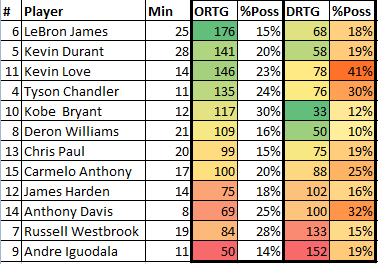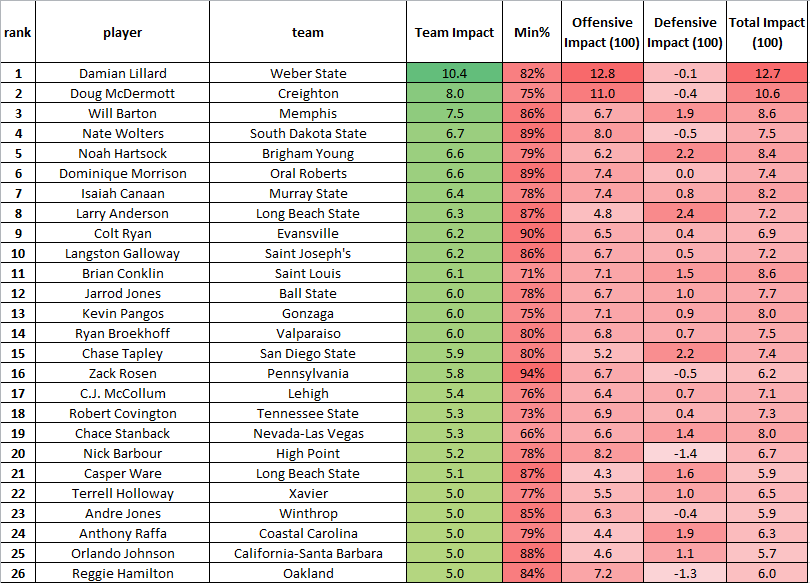EDIT: Fixed the per-game numbers.
Surprises of the month go to: Andray Blatche (
Without further ado, here are your top and bottom 26.
The Top 26
| Player | Season | OSPR | DSPR | Total SPR | SPR per Game | |
|---|---|---|---|---|---|---|
| 1 | Carmelo Anthony | 2012-13 | 10.6 | -0.7 | 9.9 | 7.5 |
| 2 | LeBron James | 2012-13 | 6.9 | 1.3 | 8.1 | 6.5 |
| 3 | Blake Griffin | 2012-13 | 7.1 | 2.5 | 9.6 | 6.4 |
| 4 | Kevin Durant | 2012-13 | 6.2 | 0.4 | 6.6 | 5.4 |
| 5 | Chris Paul | 2012-13 | 6.3 | 2.1 | 8.4 | 5.4 |
| 6 | Kobe Bryant | 2012-13 | 6.4 | -0.5 | 5.9 | 5.0 |
| 7 | Andray Blatche | 2012-13 | 4.7 | 3.6 | 8.2 | 4.8 |
| 8 | Ryan Anderson | 2012-13 | 7.9 | -1.4 | 6.5 | 4.6 |
| 9 | Tony Parker | 2012-13 | 7.3 | -0.6 | 6.6 | 4.6 |
| 10 | Paul George | 2012-13 | 4.7 | 1.0 | 5.7 | 4.5 |
| 11 | Kemba Walker | 2012-13 | 6.4 | -0.1 | 6.3 | 4.4 |
| 12 | Chris Copeland | 2012-13 | 12.7 | 1.2 | 13.9 | 4.3 |
| 13 | Russell Westbrook | 2012-13 | 4.9 | 0.8 | 5.8 | 4.2 |
| 15 | Stephen Curry | 2012-13 | 5.0 | -0.3 | 4.7 | 3.9 |
| 16 | Paul Millsap | 2012-13 | 4.1 | 1.3 | 5.4 | 3.7 |
| 17 | James Harden | 2012-13 | 4.0 | 0.5 | 4.5 | 3.7 |
| 18 | Tyson Chandler | 2012-13 | 3.7 | 1.3 | 5.0 | 3.5 |
| 19 | Andrei Kirilenko | 2012-13 | 1.1 | 3.5 | 4.6 | 3.5 |
| 21 | J.J. Hickson | 2012-13 | 5.4 | 1.0 | 6.4 | 3.4 |
| 20 | Matt Barnes | 2012-13 | 4.5 | 1.9 | 6.4 | 3.4 |
| 22 | Ed Davis | 2012-13 | 4.4 | 2.4 | 6.8 | 3.4 |
| 23 | Dwyane Wade | 2012-13 | 5.3 | -0.4 | 4.8 | 3.2 |
| 24 | David Lee | 2012-13 | 3.8 | 0.2 | 4.0 | 3.2 |
| 27 | Kyrie Irving | 2012-13 | 5.9 | -1.6 | 4.3 | 3.2 |
| 26 | Eric Bledsoe | 2012-13 | 3.6 | 4.6 | 8.2 | 3.2 |
The Bottom 26
| Player | Season | OSPR | DSPR | Total SPR | SPR per Game | |
|---|---|---|---|---|---|---|
| 387 | Daniel Gibson | 2012-13 | -5.5 | -1.7 | -7.2 | -3.9 |
| 386 | Kyle Singler | 2012-13 | -4.1 | -1.8 | -5.9 | -3.8 |
| 388 | Doron Lamb | 2012-13 | -8.9 | -1.6 | -10.5 | -3.8 |
| 382 | Mickael Pietrus | 2012-13 | -4.6 | -1.1 | -5.7 | -3.5 |
| 383 | Andre Iguodala | 2012-13 | -5.3 | 0.7 | -4.6 | -3.4 |
| 379 | Chris Singleton | 2012-13 | -5.9 | 0.1 | -5.8 | -3.3 |
| 381 | J.R. Smith | 2012-13 | -3.6 | -1.5 | -5.1 | -3.3 |
| 378 | Andrea Bargnani | 2012-13 | -3.2 | -2.2 | -5.4 | -3.2 |
| 377 | Victor Claver | 2012-13 | -11.3 | 2.0 | -9.3 | -3.2 |
| 376 | Jeff Taylor | 2012-13 | -3.1 | -2.3 | -5.4 | -3.1 |
| 374 | Jerry Stackhouse | 2012-13 | -4.0 | -2.6 | -6.6 | -3.0 |
| 375 | Bismack Biyombo | 2012-13 | -5.0 | 0.5 | -4.5 | -3.0 |
| 372 | Alonzo Gee | 2012-13 | -3.3 | -0.8 | -4.1 | -3.0 |
| 373 | Gerald Green | 2012-13 | -4.7 | -1.9 | -6.7 | -2.9 |
| 370 | Willie Green | 2012-13 | -5.6 | -2.2 | -7.8 | -2.8 |
| 369 | Festus Ezeli | 2012-13 | -7.6 | -0.9 | -8.5 | -2.6 |
| 368 | Dahntay Jones | 2012-13 | -4.1 | -2.4 | -6.5 | -2.6 |
| 367 | Austin Rivers | 2012-13 | -2.6 | -1.7 | -4.3 | -2.6 |
| 365 | Keith Bogans | 2012-13 | -9.1 | -2.6 | -11.7 | -2.6 |
| 364 | Sebastian Telfair | 2012-13 | -3.2 | -2.4 | -5.6 | -2.4 |
| 363 | Aaron Brooks | 2012-13 | -2.7 | -1.6 | -4.3 | -2.4 |
| 361 | Martell Webster | 2012-13 | -2.8 | -1.0 | -3.8 | -2.4 |
| 362 | John Salmons | 2012-13 | -1.8 | -1.8 | -3.6 | -2.4 |
| 359 | Jason Maxiell | 2012-13 | -5.4 | 1.6 | -3.8 | -2.3 |
| 360 | Tony Allen | 2012-13 | -6.1 | 1.5 | -4.6 | -2.3 |
| 358 | Nolan Smith | 2012-13 | -6.5 | -2.8 | -9.3 | -2.3 |
DSPR = (1.3xSteals - 0.1xMissedFG + 0.2xDRB + 0.5xBLK)x100/Possessions Played - 3
-OSPR can be found here.









